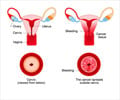In a study published in the Lancet, researchers had suggested that the success rate of preventing infections through high risk HPV virus might vary from country to country all over the world.
In a study published in the Lancet, researchers had suggested that the success rate of preventing infections through high risk HPV virus might vary from country to country all over the world .
Vaccines currently being developed against two types of virus that cause cervical cancer— HPV16 or HPV18—may prevent a larger proportion of high-risk HPV infections in Europe than sub-Saharan Africa.Population-based data of HPV-type distribution is a prerequisite to the development of new HPV screening tests and to the assessment of the effect of future vaccination on HPV infection, but these data have been limited or missing for many world regions.
Gary Clifford (International Agency for Research on Cancer, France) and colleagues compared the HPV-type distribution in representative samples of women without cervical abnormalities from 11 countries in Asia, South America, sub-Saharan Africa, and Europe. They found that, although both overall HPV prevalence and HPV16 prevalence were highest in sub-Saharan Africa, HPV-positive women from Europe and South America were significantly more likely to be infected with HPV16 than were their counterparts in sub-Saharan Africa. HPV16 was twice as frequent as any other high-risk type in all regions except sub-Saharan Africa, where HPV35 was equally common.
Dr Clifford states: “The proportion of high-risk HPV infections preventable by a vaccine for HPV16 or HPV18 might vary by region, being highest in Europe (and perhaps North America) and lowest in sub-Saharan Africa . . . Heterogeneity in HPV type distribution among women from different populations should be taken into account when developing screening tests for the virus and predicting the effect of vaccines on the incidence of infection.”
Source: Newswise, The Lancet











